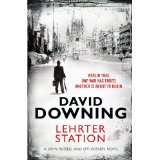Referencing Old Shanghai 2012 – From Literature to Lippy
Posted: December 23rd, 2012 | No Comments »I just realised that it was last Christmas I posted an article entitled “Referencing Shanghai: Some Mentions of the Old Town I Picked up on in 2011”. The idea was to look for casual references to old Shanghai in contemporary culture. I wrote:
“Despite the best attempts of modern Shanghai’s leaders to present the city as an aspirant International Financial Centre, regional logistics hub, mega-port and (said with straight faces at government press briefings) centre of ‘knowledge workers’, the older image of Shanghai as a raffish city, an edge city positioned between a notional western civilization and a perceived eastern barbarism, a teeming Oriental city, a criminal city persists. Pearl of the Orient can never quite nudge out Whore of the Orient. Since the early decades of the twentieth century to come from, or to have had some contact with, Shanghai was a mark of disreputability, possible nefarious undertones and a general loucheness”
2011 was, in seems, a rather fecund time for old Shanghai references – W.E. on the big screen, Upstairs Downstairs, Marple and Any Human Heart on the box, Elizabeth Wilson and Anna Funder in books as well as other TV and book references.
I’m afraid my 2012 hasn’t yielded quite such a crop, but still old Shanghai keeps popping up.
In the books stakes of course Francesca Brill’s The Harbour was the lightly fictionalised tale of Emily Hahn and Charles Boxer’s wartime love affair and, though mostly set in Hong Kong obviously, couldn’t completely ignore a reference or two to Shanghai. David Downing’s Lehrter Station (the fifth in his successful wartime Berlin spy series) has his hero John Russell searching for missing Jews in post-war Berlin and looking for one in particular thought to have swapped life in the Third Reich for Shanghai. The Shanghai plot line didn’t go anywhere but the city as a refuge for European Jewry in WW2 did get a mention. Ridley Pearson’s The Risk Agent appeared but it hasn’t come up on UK amazon yet so I haven’t been able to read it.
Little snippets of Shanghai history got through – that all time top ten bad ass William Fairburn, who developed street fighting techniques with the Shanghai Municipal Police and his famous fighting knife that became the British commando tool of preference for dispatching Nazis, gets a brief mention in Nicholas Rankin’s Ian Fleming’s Commandos: The Story of 30 Assault Unit in WWII. Movie wise I didn’t see many references; not much else beyond a few Chinese lanterns in 1890s Paris to liven up George’s garret in Bel Ami, which was otherwise a snooze-fest.
If old Shanghai did go mainstream in 2012 it was courtesy of those purveyors of lippy and blusher Revlon and their Shanghai Collection, by the ridiculously named “Gucci Westman” that launch in Autumn 2012. This brought old Shanghai into every branch of Boots!! “Channel the Orient” was a tad tacky (though I’m not one of those PC nuts who believes the word ‘Orient’ to be inherently racist and would execute anyone who used it with, well, perhaps death by a thousand cuts!!) and everything was, of course, “limited edition”. Quite what was so Shanghai about it is up to you, but clearly it proves my initial point that the image lingers!!
Go on “Channel the Orient”…you know you want to!!


Leave a Reply